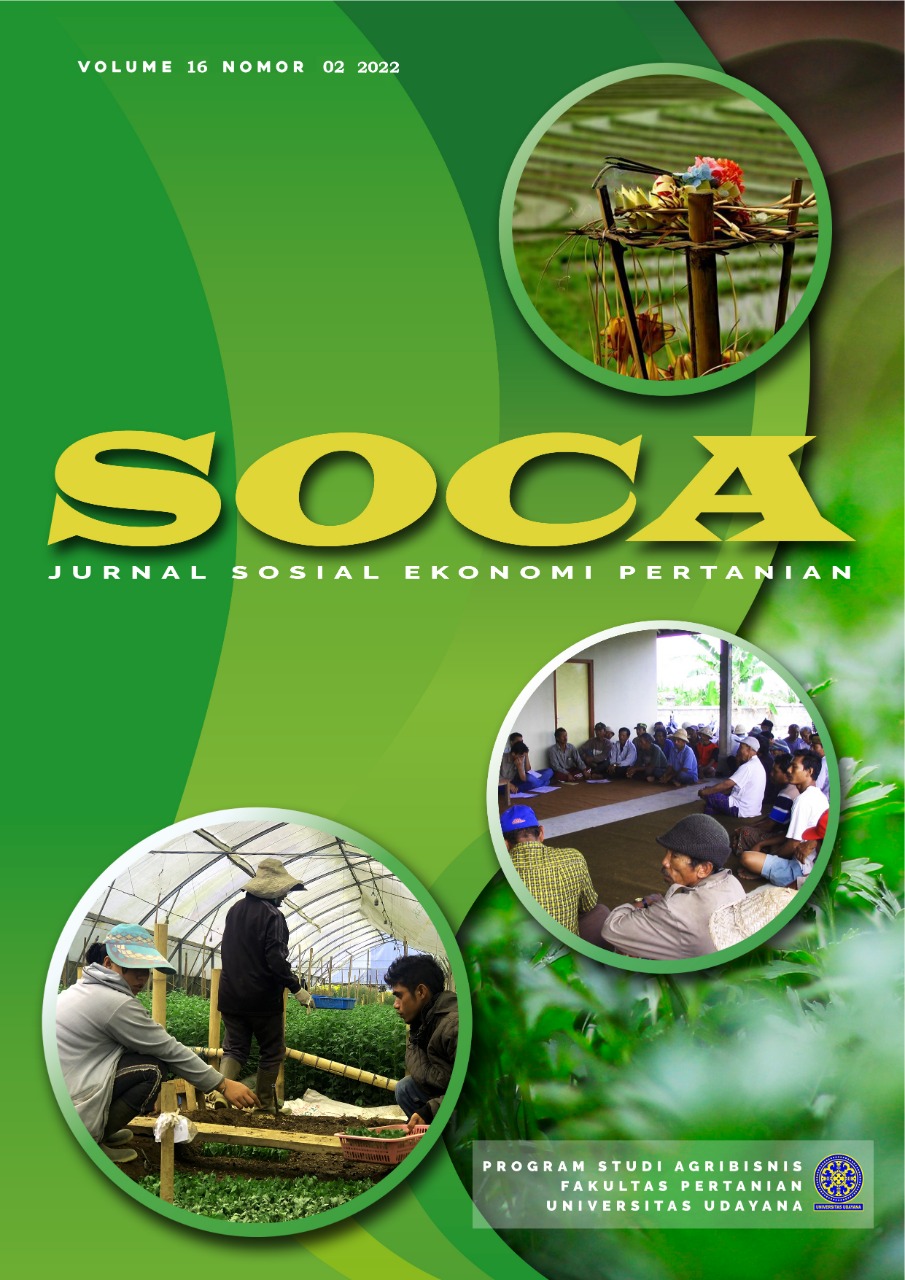The Prosperity Level of Plasma Palm Oil Farmer’s Family in the State Border Area during the New Normal Era
Abstract
This study aimed to investigate and analyze: the demographic characteristics, prosperity levels, and factors affecting the prosperity level among the plasma palm oil farmers during the new normal era. This study was conducted in a palm oil plantation area, Kembayan, Sanggau Regency, West Borneo from August to July 2020. Primary data were collected using a questionnaire that directly distributed to the partisipants. The level of prosperity was measured by the prosperous family indicators from the National Population Planning and Family Board and poverty line indicators from the National Statistical Institute. A descriptive quantitative, descriptive qualitative, and multinomial logit regression analysis applied to address the study’s objectives. Findings revealed that 51%, 23%, 17%, 8%, and 1% of the farmer’s family were classified into the prosperous family level III plus, prosperous family level III, prosperous family level II, prosperous family level I, and pre-prosperous family category, respectively. According to poverty line indicators, all farmer’s state of living were placed above the line of poverty. These findings signified that palm oil businesses in the state border area were providing sufficient amount of revenue for the farmers during the new normal era. The variabel of age, total plantation land area, and income were associated with the farmer’s family prosperity level.
Downloads
References
Budiasa, I. (2002). Studi Kelayakan Proyek Perkebunan Kelapa Sawit Pt. Henrison Inti Persada, Papua. SOCA: Socioeconomics of Agriculture and Agribusiness, 2(2), 1–19. https://ojs.unud.ac.id/index.php/soca/article/view/4009
Ditjenbun. (2019). Statistik Perkebunan Idonesia 2018-2020. Secretariate of Directorate General of Estates.
Firman, F., Suyatno, A., & Kurniati, D. (2018). Analisis Tingkat Pendapatan dan Kesejahteraan Petani Kelapa Kabupaten Sintang. Perkebunan Dan Lahan Tropika, 8(2), 61–66. https://doi.org/10.26418/plt.v8i2.29799 P-ISSN
Firmansyah, Z. (2013). Analisis Pengaruh Umur, Pendidikan, dan Upah Terhadap Produktivitas Tenaga kerja. Economic Development Analysis Journal, 2(4), 446–455.
Firmansyah, Z. (2017). Analisis Pengaruh Umur, Pendidikan, dan Upah terhadap Produktivitas Tenaga Kerja. Economics Development Analysis Journal, 4(1). https://doi.org/10.15294/edaj.v4i1.14808
Galawat, F., & Yabe, M. (2012). Evaluation of technical, allocative, and economic efficiency in rice production; A case.study on rice farmers in brunei darussalam. Journal of the Faculty of Agriculture, Kyushu University, 57(1), 317–325. https://doi.org/10.5109/22086
Hakim, L., & Sugiyanto, E. (2018). Manajemen Perubahan Organisasi Sebagai Upaya Peningkatan Kinerja Perusahaan di Industri Batik Laweyan Surakarta. Benefit: Jurnal Manajemen Dan Bisnis, 3(1), 49. https://doi.org/10.23917/benefit.v3i1.6562
Herdiansyah, H., Negoro, H. A., Rusdayanti, N., & Shara, S. (2020). Palm oil plantation and cultivation: Prosperity and productivity of smallholders. Open Agriculture, 5(1), 617–630. https://doi.org/10.1515/opag-2020-0063
Jámbor, A., Czine, P., & Balogh, P. (2020). The impact of the coronavirus on agriculture: First evidence based on global newspapers. Sustainability (Switzerland), 12(11). https://doi.org/10.3390/su12114535
Lalita, R., Ismono, R. H., & Prasmatiwi, F. E. (2019). Kajian Sosial Ekonomi dan Tingkat Kesejahteraan Rumah Tangga Petani Kelapa Sawit di Kabupaten Tulang Bawang. Jurnal Ilmu-Ilmu Agribisnis, 7(2), 195. https://doi.org/10.23960/jiia.v7i2.195-202
Mehraban, N., Kubitza, C., Alamsyah, Z., & Qaim, M. (2021). Oil palm cultivation, household welfare, and exposure to economic risk in the Indonesian small farm sector. Journal of Agricultural Economics, 72(3), 901–915. https://doi.org/10.1111/1477-9552.12433
Munardi, & Situmorang, D. (2018). Faktor-Faktor yang Mempengaruhi Tingkat Kesejahteraan Petani Sawit di Kecamatan Gunung Meriah Kabupaten Aceh Singkil. Jurnal Ekonomi Pertanian Unimal, 1(1), 23. https://doi.org/10.29103/jepu.v1i1.788
Novahadi, R., Muani, A., & Imelda. (2013). Analisis Tingkat Kesejahteraan Keluarga Petani Kebun Plasmaa Kelapa Sawit PT. Prakarsa Tani Sejati (Studi Kasus di Desa Muara Jekak Kecamatan Sandai Kabupaten Ketapang). Jurnal Sains Mahasiswa Pertanian, 2(3), 1–10. https://jurnal.untan.ac.id/index.php/jspp/article/view/3431
Oktiani, N., Utami, C. P., & Yuliantari, K. (2019). Pendekatan Clustering Budaya Organisasi dalam Upaya Peningkatan Kinerja Karyawan. JKBM (Jurnal Konsep Bisnis Dan Manajemen), 6(1), 33. https://doi.org/10.31289/jkbm.v6i1.2662
Pinilih, M., Rakhmawati, D., & Rosyidi, R. (2021). Farmers’ term of trade in Indonesia: An overview during pandemic COVID-19. IOP Conference Series: Earth and Environmental Science, 746(1). https://doi.org/10.1088/1755-1315/746/1/012012
Purwanto, A., & Taftazani, B. M. (2018). Pengaruh Jumlah Tanggungan Terhadap Tingkat Kesejahteraan Ekonomi Keluarga Pekerja K3L Universitas Padjadjaran. Focus : Jurnal Pekerjaan Sosial, 1(2). https://doi.org/10.24198/focus.v1i2.18255
Relawati, R., Ariadi, B. Y., Bakhtiar, A., & Minasyan, S. (2021). The changes of household food expense during COVID-19 pandemic: A case study in Indonesia and Armenia. SOCA: Journal of Socio-Economics of Agriculture and Agribusiness, 15(2), 416–426. https://doi.org/https://doi.org/10.24843/SOCA.2021.v15.i02.p16
Silaban, E. P. K., Satmoko, S., & Prayoga, K. (2021). The Livelihood Strategy of Rubber Tapper Households. SOCA: Jurnal Sosial Ekonomi Pertanian, 15(3), 427–438.
Siradjuddin, I. (2015). Dampak Perkebunan Kelapa Sawit terhadap Perekonomian Wilayah di Kabupaten Rokan Hulu. Jurnal Agroteknologi, 5(2). https://doi.org/10.24014/ja.v5i2.1349
Victor, A., Kurniawan, H. M., & Yuliarto, R. T. (2018). Analisis Tingkat Kesejahteraan Keluarga Petani Kebun Plasmaa Kelapa Sawit Pada PT. Agronusa Investama Di Kecamatan Sengah Temila Kabupaten Landak. E-Jurnal Equilibrium …, 1(1), 1–7. https://jurnal.upb.ac.id/index.php/equalibrium/article/view/58
Yunus, S., Zainal, S., & Jalil, F. (2019). Cooperation among farming stakeholders in farmers poverty reduction in aceh. International Journal of Innovation, Creativity and Change, 9(5).













